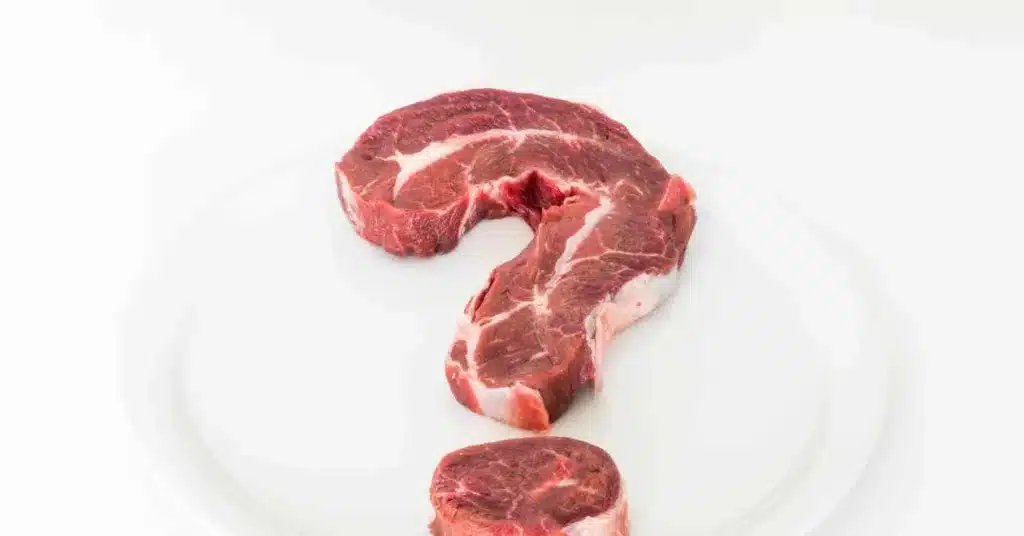Impossible Meat has rapidly gained popularity as a plant-based alternative that mirrors the taste and texture of traditional beef. Introduced by Impossible Foods, this innovative product caters to both vegetarians and meat-eaters seeking sustainable food choices.
Its success largely stems from its ability to cook, sizzle, and even “bleed” like real meat, thanks to a key ingredient called heme, derived from soy plants. This feature has made it a favorite in restaurants and home kitchens alike.
Enthusiasm for Impossible Meat also rides on a growing consumer awareness of environmental and ethical issues linked to animal farming. As it expands globally, the product continues to attract those eager to reduce their meat consumption without sacrificing flavor, proving that plant-based alternatives can win over a broad audience.
Table of contents
Storage of cooked Impossible in the fridge
Cooked Impossible Meat, like many plant-based alternatives to traditional meat, requires proper storage to maintain its quality and safety. Once cooked, Impossible Meat should be stored in the refrigerator if it is not consumed immediately. It can safely last in the fridge for about 3 to 5 days when kept at a consistent temperature of 40 degrees Fahrenheit or below, which is the standard safe zone to inhibit bacterial growth.
To optimize its shelf life, it’s important to store cooked Impossible Meat in an airtight container. This not only helps maintain its freshness but also prevents it from absorbing any odors from other foods in the refrigerator. Using shallow containers can help cool the meat more evenly and quickly, reducing the risk of bacterial growth during the cooling process.
When storing cooked Impossible Meat, it’s also beneficial to let it cool slightly before refrigerating. However, avoid leaving it at room temperature for more than two hours, or one hour if the ambient temperature is above 90 degrees Fahrenheit. Bacteria that can cause foodborne illness grow rapidly at these temperatures.
If you find yourself with leftover Impossible Meat that you won’t consume within a few days, freezing is an excellent option. Cooked Impossible Meat can be stored in the freezer for up to 3 months. When ready to eat, it’s best to thaw it in the refrigerator overnight rather than at room temperature to keep it safe from bacterial growth.
Finally, always check for signs of spoilage before consuming stored Impossible Meat. Spoilage indicators include an off smell, a slimy texture, or a discolored appearance. If you observe any of these signs, it is safest to discard the meat. Following these storage guidelines will ensure that your cooked Impossible Meat remains delicious, safe, and of the highest quality whenever you choose to enjoy it.
Factors affecting the shelf life of cooked Impossible Meat

Several factors influence the shelf life of cooked Impossible Meat, determining how long it remains safe and palatable in storage. Understanding these factors can help you maximize the freshness and safety of this popular plant-based product.
- Storage Temperature: The most critical factor is the temperature at which the cooked meat is stored. To prevent the growth of harmful bacteria, cooked Impossible Meat should be refrigerated at or below 40 degrees Fahrenheit. Temperatures above this can accelerate bacterial growth, leading to faster spoilage
- Air Exposure: Exposure to air can degrade the quality of cooked Impossible Meat. Air can dry out the meat and promote the growth of aerobic bacteria and mold. Storing the meat in airtight containers or wrapping it tightly with plastic wrap or aluminum foil can significantly extend its shelf life by minimizing exposure to air.
- Moisture Content: High moisture levels in food can encourage bacterial growth. Cooked Impossible Meat, particularly if not stored properly, can retain moisture that fosters the proliferation of bacteria. Ensuring it’s dry and stored in conditions that do not promote excess moisture can help maintain its integrity longer.
- pH Levels: The acidity or alkalinity of the food also affects its shelf life. Foods with lower pH (more acidic) tend to inhibit bacterial growth. While Impossible Meat is designed to mimic real meat, its plant-based ingredients may interact differently with pH levels, potentially influencing how long it can be safely stored.
- Cross-Contamination: During storage or preparation, cross-contamination with other foods, especially raw meats or contaminated surfaces, can introduce bacteria to cooked Impossible Meat. Practicing good kitchen hygiene, such as using separate utensils and surfaces for different types of foods, is essential.
- Initial Cooking Temperature: Properly cooking Impossible Meat to the recommended internal temperature can kill pathogens present before storage. Insufficient cooking can leave bacteria that might continue to grow during storage, reducing the meat’s shelf life.
Find expert tips on storing and reheating Impossible meat leftovers – How should I store and reheat leftovers? – Impossible Foods
Best practices for storing cooked Impossible Meat
Here are some best practices to follow when storing this plant-based meat alternative:
- Cooling Before Storage: Allow cooked Impossible Meat to cool down before storing it in the refrigerator. However, it’s crucial to minimize the time it spends at room temperature to avoid bacterial growth. Do not leave cooked meat out for more than two hours, or one hour if the temperature is above 90 degrees Fahrenheit.
- Refrigeration Temperature: Store cooked Impossible Meat in the refrigerator set to 40 degrees Fahrenheit or below. This temperature range slows down bacterial growth and helps maintain the quality of the meat.
- Airtight Containers: Use airtight containers to store cooked Impossible Meat. This prevents the meat from absorbing odors of other foods in the refrigerator and also minimizes its exposure to air, which can cause drying and spoilage.
- Separate Storage: Keep cooked Impossible Meat separate from raw foods or uncooked ingredients to prevent cross-contamination. This is especially important to maintain food safety standards.
- Use Shallow Containers: Store the meat in shallow containers to allow it to cool more evenly and quickly. Deep containers can trap heat and moisture, which can encourage bacterial growth.
- Label and Date: Always label your storage containers with the date the meat was cooked. This helps you track how long it has been stored and ensures you use it within its optimal freshness period, generally within 3 to 5 days.
- Freezing for Long-Term Storage: If you won’t be consuming the cooked Impossible Meat within a few days, consider freezing it. Properly wrapped and stored, it can last up to 3 months in the freezer. Thaw it in the refrigerator overnight when ready to use.
Learn more about storing plant-based meats from Impossible Foods Medium: How long does Fake Meat last (Cooked and uncooked)
How to tell if cooked Impossible Meat has gone bad

Identifying whether cooked Impossible Meat has gone bad is crucial for ensuring food safety and avoiding the risks associated with spoiled food. Here are key indicators to look out for:
- Odor: Fresh cooked Impossible Meat should have a mild, pleasant smell. If you notice any off-putting or sour odors, it’s a strong indication that the meat has spoiled. Trust your nose; any unpleasant smells are a clear sign that the meat should not be consumed.
- Texture: Examine the texture of the meat. If the surface has become slimy or sticky, it suggests bacterial growth. Fresh Impossible Meat should feel firm and dry to the touch. Any changes in texture from how it felt when first cooked should be considered a warning.
- Color: Look for any significant changes in color. While some slight discoloration might occur due to oxidation, pronounced changes or the presence of mold spots (which may appear white, green, or black) are signs that the Impossible Meat is no longer good to eat.
- Taste: If you’re unsure based on smell, texture, and appearance alone, a small taste can be the final test. However, this should be done cautiously. If the meat tastes different than it did when freshly cooked, particularly if it has a sour or unpleasant flavor, it should not be eaten.
FAQs
How long can cooked Impossible Meat stay fresh in the fridge?
Cooked Impossible Meat can be safely stored in the refrigerator for about 3 to 5 days. Make sure it is kept at a consistent temperature of 40 degrees Fahrenheit or below, in an airtight container to maximize freshness.
Can I freeze cooked Impossible Meat?
Yes, you can freeze cooked Impossible Meat. It should be stored in airtight containers or freezer bags to prevent freezer burn. Properly stored, cooked Impossible Meat can last up to 3 months in the freezer. Thaw it in the refrigerator overnight when you are ready to use it again.
How do I know if cooked Impossible Meat has gone bad?
Spoiled cooked Impossible Meat typically presents several signs including a sour or unpleasant odor, a slimy or sticky texture, and visible mold or discoloration. If you observe any of these signs, it is best to discard the meat to avoid the risk of foodborne illness.
Can I reheat Impossible Cooked Meat?
Yes, you can reheat cooked Impossible Meat. For best results, reheat it to an internal temperature of 165 degrees Fahrenheit, which is safe for consumption. You can use a microwave, oven, or stovetop to reheat it thoroughly.
Can I eat cooked Impossible Meat left out overnight?
If cooked Impossible Meat is left out at room temperature for more than two hours, or one hour if the temperature exceeds 90 degrees Fahrenheit, it should not be consumed. Bacteria grow rapidly at these temperatures, and consuming meat left out for longer can lead to foodborne illness.
What is the best way to store cooked Impossible Meat in the refrigerator?
Store cooked Impossible Meat in shallow airtight containers to minimize exposure to air and moisture. Make sure to set the refrigerator’s temperature below 40 degrees Fahrenheit to keep the meat safe and fresh.
Does cooking Impossible Meat kill all bacteria?
Cooking Impossible Meat to the recommended temperatures can kill most bacteria, but improper handling post-cooking or inadequate storage can still lead to bacterial growth. Always ensure to cook it thoroughly and store it correctly.
Are there any special considerations for handling Impossible Meat compared to regular meat?
Handling Impossible Meat, although plant-based, requires applying the same hygiene practices as regular meat to prevent cross-contamination. This includes using separate utensils and cutting boards for cooked and uncooked foods and washing hands thoroughly when handling.
Conclusion
Cooked Impossible Meat offers a versatile and sustainable alternative to traditional meat, fitting seamlessly into various diets and culinary preferences.
Remember to follow these guidelines closely to extend the freshness of your cooked Impossible Meat, making the most of this innovative plant-based product.
Whether you’re a seasoned vegan or a curious omnivore, cooked Impossible Meat provides a delicious and environmentally friendly option for your meals.

